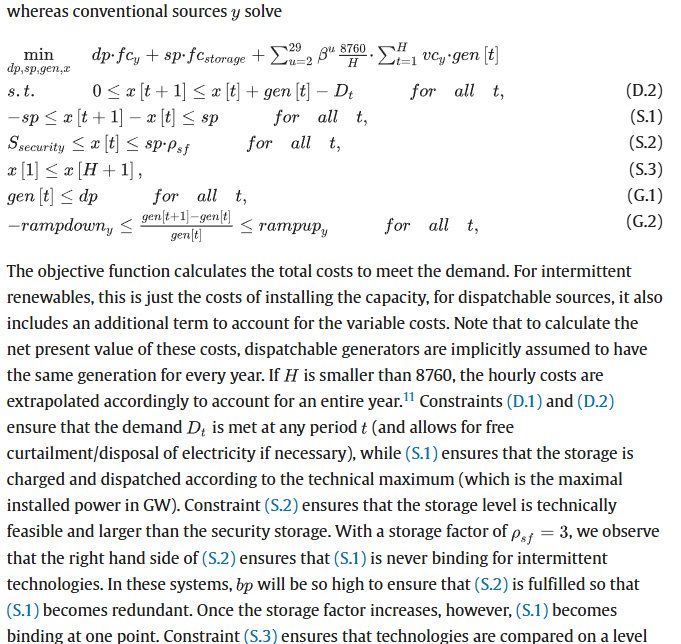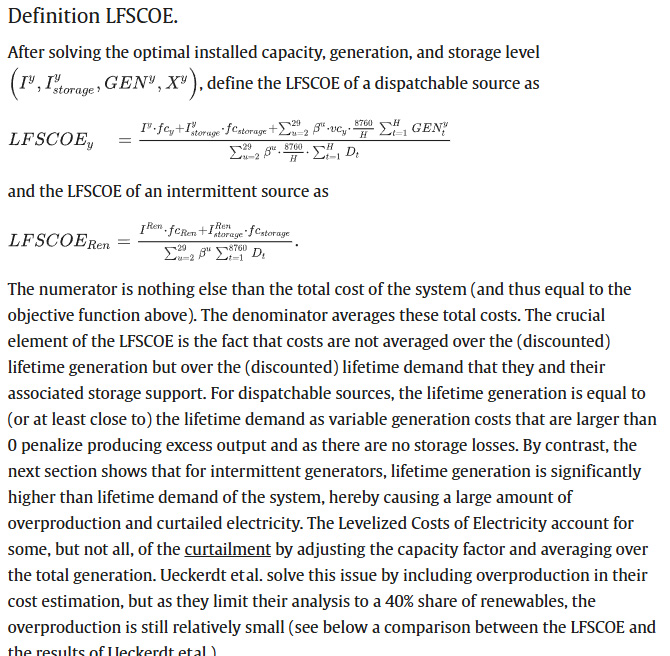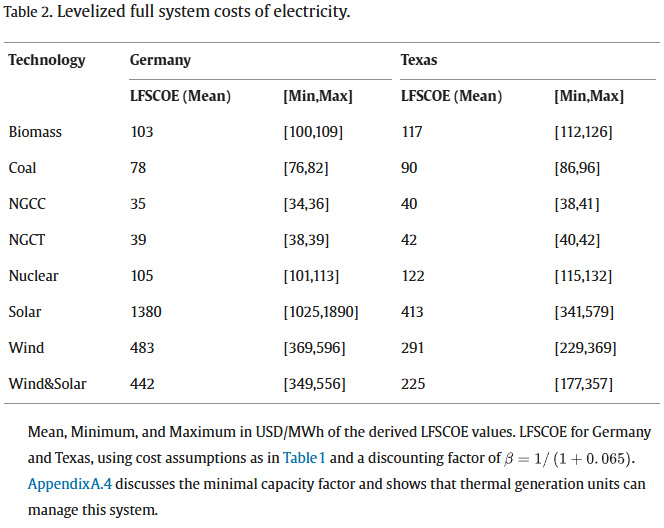Environment & Energy
Related: About this forumLFSCOE: The True Cost of Solar and Wind Energy in Texas and Germany in Answer to the Question...
"...if it (solar and wind so called "renewable energy" ) is the cheapest source while not emitting CO2, why are countries still investing heavily in new gas and coal power plants? Is it just because coal generation may employ more people in politically sensitive regions of the country, or are there financial reasons not reflected in the LCOE?"
This interesting question, which should be a pretty obvious question to ask, although apparently it isn't often asked, given that the trillions of dollars squandered on solar and wind energy has no effect whatsoever on slowing the acceleration of the collapse of the planetary atmosphere, nor have they resulted in a suspension of the construction of coal and gas plants anywhere on the planet, is asked in this wonderful paper:
Robert Idel, Levelized Full System Costs of Electricity, Energy, Volume 259, 2022, 124905.
The paper, of which Dr. Idel is the sole author, is an outgrowth of his Ph.D. Thesis written when he was a graduate student at Rice University’s Baker Institute for Public Policy, 6100 Main Street MS-40, Houston, 77005, TX, United States. Dr. Idel is a native of Germany, a coal dependent antinuclear "heaven" - at least according to the advertising - and as he was studying at Rice, in Texas, it was reasonable for him to focus on these two regions, both of which have heavy penetration of solar and wind junk; both burn large amounts of fossil fuels to generate electricity, dumping the waste directly into the planetary atmosphere, where said waste is killing said atmosphere.
Dr. Idel's thesis is here: Efficiency in a New World: Electricity With Renewables and Storage.
Dr. Idel is no longer an academic, by the way. He is now a Director level employee of Trip Advisor where he manages price auctions according to his Linkedin page. He is, however, a man after my own heart, because his hobby noted on Linkedin is connected with his love, understanding the costs of energy, which he does on his own time. Good for him. He gives a shit.
Another example of a person who worked on science in his case, economics in Dr. Idel's case, on his own time is a guy named Albert Einstein, who while working as a Swiss Patent Examiner, wrote 4 papers in 1905 that changed the history of the world, whereupon, Dr. Einstein was ultimately persuaded to give up his Patent job and reenter academia. This is not a claim that Dr. Idel is Dr. Einstein, but rather that some people's passions matter whether professional or not. My opinion is that Dr. Idel's paper matters.
As of now, Dr. Idel's paper has 41 citations according to Google Scholar, most of which are Social Science papers. I'm personally not a tremendous fan of social "science" if truth be told, but economics is generally included in this category and has a stronger mathematical basis than say, sociology or political "science" and the others, and is thus "sciencey" despite not generating strict mathematically based predictive laws for which precision can be measured unambiguously. (The famous mathematician John Nash won his Nobel Prize in Economics.) In some of these citations one can read all about the issue of say, socialism vs. capitalism, which to my mind has very little to do with the realities connected with the carbon intensity of primary energy and the questionable thermodynamically nonsensical habit of declaring energy storage "green."
"LCOE" which stands for "Levelized Cost of Energy" is a widely used metric by the way, very much so by governmental and international agencies, which declare, as do many of the antinukes around here and elsewhere, that solar and wind energy are allegedly "cheap" without wondering - as should be obvious - about Dr. Idel's question. Again: ...if it (solar and wind so called "renewable energy) is the cheapest source while not emitting CO2, why are countries still investing heavily in new gas and coal power plants?"
Why indeed?
As I note, advocates of the solar and wind industry one sees around here couldn't care less about the state of the planetary atmosphere. They are entirely disinterested in attacking fossil fuels except in vague hollow mutterings about papers and commentary about the work of the climate scientist Jim Hansen. Their main interest is in attacking what I contend is the only acceptable form of primary energy, nuclear energy. Their success in so doing has been a disaster for humanity and all living things, but conversely, very successful for the fossil fuel industry, which never stops growing, and won't, until the last molecule of carbon dioxide is dumped into the atmosphere.
From the introduction to the paper:
The lifetime costs of an investment are key measures for decision-making. This is true for investment decisions in electricity markets as well, where the most popular measure to compare different technologies for generating electricity are the Levelized Costs of Electricity (LCOE). To calculate the LCOE, the expected lifetime generation of an electricity generating plant and the expected costs to generate the lifetime electricity are calculated. After dividing total costs by total generation, the final number (usually in USD/MWh) is derived. Input assumptions like capacity costs, maintenance, marginal operating costs, or average capacity factor, which is particularly relevant for renewable sources of electricity, are crucial for the calculation and vary by study.1 For example, Lazard estimates the LCOE of coal between 66 and 152 USD/MWh and onshore wind between 28 and 54 USD/MWh, whereas the U.S. Energy Information Agency (EIA) derives LCOE for coal of 76 USD/MWh and LCOE for wind of 40 USD/MW [1], [2]. Many recent studies indicate that the LCOE are the lowest for onshore wind and utility-scale solar using photovoltaic cells (hereafter referred to as “solar PV” or “solar”), findings frequently cited by proponents of a fast transition towards renewable electricity. Nevertheless, if it is the cheapest source while not emitting CO2, why are countries still investing heavily in new gas and coal power plants? Is it just because coal generation may employ more people in politically sensitive regions of the country, or are there financial reasons not reflected in the LCOE?
Critiques of LCOE are not scarce. Joskow is one of the first to point out that LCOE ignore the costs associated with intermittency [3]. It is easy to see the fundamental misunderstanding in LCOE: The LCOE describe the costs of generating electricity. However, the function of supply in electricity markets is not to generate electricity but to provide a specified amount of electricity to a specific place at a particular time. The locational aspect adds significant additional costs to renewables that are generally less flexible about where they can be sited than fossil fuel plants. As a result, a larger grid is required to transport the electricity from, e.g., hydropower plants to the demand in urban areas. These transmission costs are partly taken care of in some LCOE estimates when a transmission cost adder is included in the LCOE. But the timing aspect turns out to be even more crucial and the focus of this paper. Many renewables (like wind and solar) are intermittent and non-dispatchable (hereafter referred to just as “intermittent” unless further specified), and some that are not intermittent (like run-of-river-hydro) are often not fully dispatchable.2
The italics are mine.
"Dispatchable" energy is defined as energy systems that can facilely follow load, that is ramp up when there is a demand surge, and ramp down when demand falls. Obviously solar energy isn't capable of "ramping up" in a dangerous extreme heating event lasting well into the evening hours. Events such as this are increasingly common because the trillion dollar solar industry has done nothing - absolutely and positively nothing - to arrest the degradation of the planetary atmosphere.
For the record, modern nuclear plants typically run at better than 90% capacity utilization, sometimes 100% capacity utilization - they are the most reliable energy systems on the planet - and thus are not considered "dispatchable." There are technical reasons why a nuclear power plant is slow to start as currently designed. However, using advanced designs, for instance that proposed by Terrapower and others, they can store short term energy in the most thermodynamically efficient way, as heat.
Anyway...
Dr. Idel works from a supposition that it is possible to go to "100% renewable energy" a subject prattled about endlessly year after year decade after decade as the planet burns, the claim that "energy storage" can make the currently non-dispatchable so called "renewable energy" dispatchable with batteries and or (worse) hydrogen. He then evaluates cost.
As an economist he can rely - as all good science ultimately does - on mathematics. The following is posted as a graphics object to avoid the limitations of the DU editor:


...and so on.
The text continues (again as a graphics object) later:

Additional text (as text):
Starting with real market data for hourly demand, on-shore wind capacity factor,13 and solar capacity factor from 2012–2019 for Germany and Texas, the costs per MWh for each technology and year are calculated by solving the minimization problem as described above.14 We then define the LFSCOE of a technology as the mean of the costs per MWh from each of the 8 years. Allowing also for a wind & solar mix, Table 2 and Fig. 1 display the LFSCOE for each technology and market as well as the interval of the costs for each year (note the different scale of the y-axis).
Several interesting observations can be made. First, neither wind nor solar nor the wind & solar mix seem economically competitive to the dispatchable sources on a LFSCOE basis. Even the LFSCOE value of the wind & solar mix in Texas, which is the most competitive of the renewable technology installations considered, is almost twice as high as the LFSCOE value of the most expensive dispatchable technology.15 These differences stem from the storage requirement and low capacity factors for wind and solar, see Appendix A.5. Second, while the LFSCOE for the conventional sources are slightly lower in Germany than in Texas, the LFSCOE for wind and especially solar are much higher in Germany (e.g. 1380 USD/MWh for solar in Germany vs. 413 USD/MWh for solar in Texas).
Table 2:

Figure 1:

Nothing in this fine paper will stop antinukes from attacking the only infinitely expandable climate gas free form of energy, nuclear energy, prattling on stupidly about Three Mile Island and other crap in their bizarre little obsessions, while killing people and the planet by ignoring fossil fuels about which they couldn't care less.
And this raises another point, which is that the LFSCOE proposed by Dr. Idel, ignores yet another factor, external costs. These are the costs associated with the health risks of fossil fuels, the land destroyed by mining for so called "renewable energy" as a result of its extremely poor energy to mass ratios, the wilderness trashed to install this junk, and the ultimate cost of hauling all that crap away and disposing of it, on a scale of hundreds of millions of tons, in 20 to 25 years when it all becomes landfills.
Some of these external costs are difficult to quantify as they are aesthetic, the cost of species lost to water poisoned by mine runoff, the cost of ruined landscapes, etc., others, such as health costs, somewhat more amenable to analysis.
It's pretty clear to me, if not people at the level of antinukism however that table 1 and the commentary about it answers the question - which should have been obvious - that Dr. Idel asks. The answer is that solar and wind are not competitive. They are unaffordable, incredibly expensive.
I trust you are having a pleasant afternoon.
Delarage
(2,468 posts)But, unfortunately, I am still grid-connected. For that I am not opposed to nukes, but I worry about vulnerable grids. Someday I want to live in a net-zero home....with my solar panels powering my car & everything.